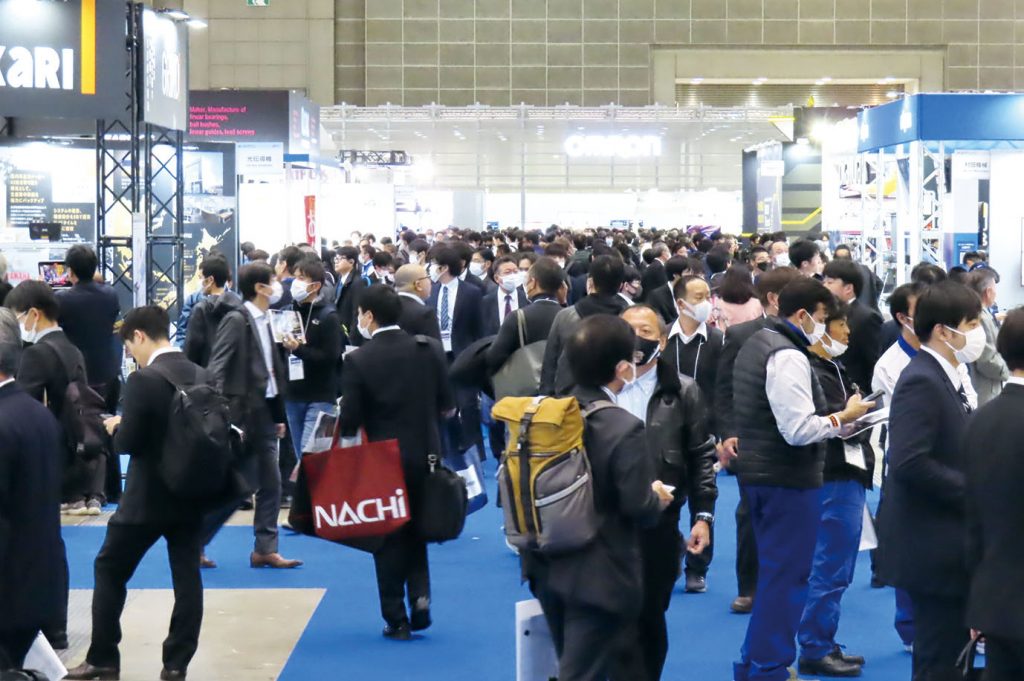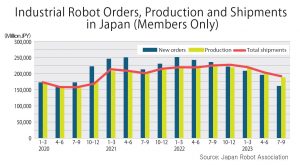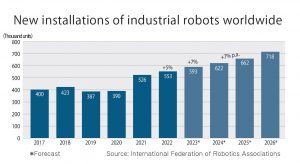
- News
- Basics
- Products
- JP Job shop
- Exhibition
- Interview
- Statistic
- PR
- Download
- Special contents
News
January 24, 2024

The industrial robot industry in Japan is stagnating in terms of current orders. Owing to the strong order backlog in 2022, the production value, shipments, and sales of each company did not decline much until the first half of 2023, despite declining orders. In the second half of 2023, however, production and shipments also declined visibly. Interest in robots is actually quite high, as evidenced by the fact that attendance at the 2023 International Robot Exhibition (iREX2023), one of the world’s largest robot exhibitions, held from November 29 to December 2 last year, exceeded the pre-pandemic number.
Could the industrial robot industry be on the rise again in 2024?

Last year’s iREX 2023, crowded with visitors
Quarterly Japanese industrial robot orders (members only) announced by the Japan Robot Association peaked in January-March 2022 and has been steadily declining. In January-March 2022, the order value was 256.677 billion yen, but it dropped to 161.038 billion yen in July-September 2023. The value of shipments peaked in October-December 2022 and yet remained above 200 billion yen in January-March and April-June 2023. However, the value of shipments finally fell below 200 billion yen in July-September 2023, indicating a deterioration in business confidence.
In this situation, iREX2023 was held from November 29 to December 2, 2023. With 148,125 visitors, the exhibition became its largest ever, surpassing the number of visitors at the 2019 exhibition before the pandemic. The interest in robotics is very high. One of the main reasons for this may be the labor shortage. Japan has a declining birthrate and an aging population, and while the demand for labor is huge, the working-age population is declining. There is no doubt that robotics is one of the key solutions to continue and develop business without losing out to the labor shortage.
 The labor shortage is not just a problem in Japan. The Japanese subsidiary of ManpowerGroup, a human resources services company with offices in 70 countries and regions around the world, conducted a survey of 39,000 employers in 41 countries and regions, including Japan, on their perceptions of the labor shortage. The results showed that 78% of employers in Japan, and 77% of employers on average worldwide, feel a shortage of human resources. Ten years ago, in the 2013 survey, the global average was 50 points lower than Japan’s, but now it is almost at the same level, indicating that the shortage of human resources is becoming more serious around the world, as it is in Japan.
The labor shortage is not just a problem in Japan. The Japanese subsidiary of ManpowerGroup, a human resources services company with offices in 70 countries and regions around the world, conducted a survey of 39,000 employers in 41 countries and regions, including Japan, on their perceptions of the labor shortage. The results showed that 78% of employers in Japan, and 77% of employers on average worldwide, feel a shortage of human resources. Ten years ago, in the 2013 survey, the global average was 50 points lower than Japan’s, but now it is almost at the same level, indicating that the shortage of human resources is becoming more serious around the world, as it is in Japan.
 Although the robotics market is sluggish in the short term, it is expected to expand in the medium to long term. According to the International Federation of Robotics (IFR), the number of newly installed industrial robots worldwide is expected to grow at a compound annual growth rate of 7% from 2023 to 2026. Japan manufactures about half of the world’s industrial robots and is expected to share some of the growing global robotics market.
Although the robotics market is sluggish in the short term, it is expected to expand in the medium to long term. According to the International Federation of Robotics (IFR), the number of newly installed industrial robots worldwide is expected to grow at a compound annual growth rate of 7% from 2023 to 2026. Japan manufactures about half of the world’s industrial robots and is expected to share some of the growing global robotics market.
And it is not just arm-type industrial robots that are on the rise; according to the IFR, the production of transportation and logistics robots is growing rapidly worldwide. Warehouses use a variety of robots, from small autonomous mobile robots (AMR) to large automated robotic warehouses. In 2022, global sales of transportation and logistics robots reached more than 86,000 units, an increase of 44% year-on-year.
The potential demand for both industrial arm robots and logistics robots is enormous.
By: Yuya Sone
Staff Editor, SEISANZAI Japan

Hiroshi Fujiwara, IFR Delegate for Asia; Executive Director, Japan Robot Association (JARA)
When will the sluggish order situation in the robotics industry pick up? The honest answer is: “There are too many uncertainties to say”.
The Russian invasion of Ukraine in 2022 was unpredictable, and then a massive conflict broke out between the Palestinian Islamic organization Hamas and Israel in 2023. No one expected the fighting to be so intense a year ago, though the Middle East has always been a potential flashpoint.
Just when it seemed that the shortages of semiconductors and other materials had eased and the disruptions to international logistics, including container shortages, had subsided, new problems have arisen. It is hard to say “this will happen this year”.
Automation through robots is advancing in a wide range of industries, and one of the areas where we expect to see more investment is in electric vehicles. In addition to the manufacturers of complete vehicles, the suppliers of parts to these manufacturers are expected to make significant investments. Although various investments in electric vehicles are already underway, the demand for electric vehicles itself largely depends on the policies and subsidies of each country, and full-scale, large-scale investments are yet to come.
The production equipment industry, including robotics, is strongly affected by the economic climate. At iREX 2023, we received many comments from exhibitors that “the percentage of visitors who are not just gathering information, but are seriously searching for the right solution for their company with a view to implementing such a solution has increased”. I feel that “a society where robots are normal and everywhere” is becoming a reality.
January 11, 2024
January 5, 2024